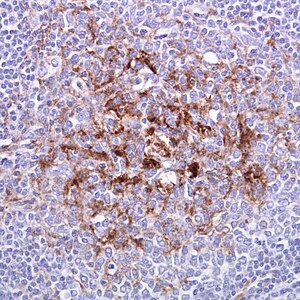Creutzfeldt–Jakob
| Creutzfeldt–Jakob disease | |
|---|---|
 |
|
| Biopsy of the tonsil in variant CJD. Prion protein immunostaining. | |
| Pronunciation | |
| Specialty | Neurology, psychiatry |
| Symptoms |
Early: memory problems, behavioral changes, poor coordination, visual disturbances Later: dementia, involuntary movements, blindness, weakness, coma |
| Usual onset | Around 60 |
| Types | Sporadic, hereditary, acquired |
| Causes | Prion |
| Diagnostic method | After ruling out other possible causes |
| Differential diagnosis | Encephalitis, chronic meningitis, Huntington’s disease, Alzheimer's disease |
| Treatment | Supportive care |
| Prognosis | 90% die within a year of diagnosis |
| Frequency | 1 per million per year |
| Classification |
· ·
|
|---|---|
| External resources |
Creutzfeldt–Jakob disease (CJD) is a universally fatal brain disorder. Early symptoms include memory problems, behavioral changes, poor coordination, and visual disturbances. Later dementia, involuntary movements, blindness, weakness, and coma occur. About 90% of people die within a year of diagnosis.
CJD is believed to be caused by a protein known as a prion. Infectious prions are misfolded proteins that can cause normally folded proteins to become misfolded. Most cases occur spontaneously, while about 7.5% of cases are inherited from a person's parents in an autosomal dominant manner. Exposure to brain or spinal tissue from an infected person may also result in spread. There is no evidence that it can spread between people via normal contact or blood transfusions. Diagnosis involves ruling out other potential causes. An electroencephalogram, spinal tap, or magnetic resonance imaging may support the diagnosis.
There is no specific treatment.Opioids may be used to help with pain, while clonazepam or sodium valproate may help with involuntary movements. CJD affects about one per million people per year. Onset is typically around 60 years of age. The condition was first described in 1920. It is classified as a type of transmissible spongiform encephalopathy. CJD is different from bovine spongiform encephalopathy (mad cow disease) and variant Creutzfeldt–Jakob disease (vCJD).
The first symptom of CJD is usually rapidly progressive dementia, leading to memory loss, personality changes, and hallucinations. Myoclonus (jerky movements) typically occurs in 90% of cases, but may be absent at initial onset. Other frequently occurring features include anxiety, depression, paranoia, obsessive-compulsive symptoms, and psychosis. This is accompanied by physical problems such as speech impairment, balance and coordination dysfunction (ataxia), changes in gait, rigid posture, and seizures. In most patients, these symptoms are accompanied by involuntary movements and the appearance of an atypical, diagnostic electroencephalogram tracing. The duration of the disease varies greatly, but sporadic (non-inherited) CJD can be fatal within months or even weeks. Most victims die six months after initial symptoms appear, often of pneumonia due to impaired coughing reflexes. About 15% of patients survive for two or more years.
...
Wikipedia
